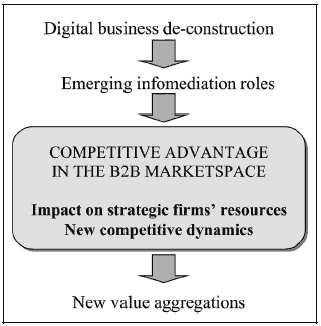By providing a wide range of opportunities linked to digital platforms, companies can now de-construct traditional vertical value chains and convert them into more flexible and synchronic value aggregations.
Electronic commerce is the main driving force behind this transformation since companies can now carry out transactions in goods, services and information in digital form. In this sense, online business-to-business relations play a central role in changing the structure of vertical value chains.
Since b2b transactions are much more complex than those involving the final consumer, b2b e-commerce develops in a more complex scenario.1
For instance, infomediaries are needed to reorganise b2b networks because, unlike what occurs in the b2c environment, companies are unable to directly exploit the benefit of e-commerce on their own.2
New categories of intermediaries (trading hubs, auctioneers, vortals, .....) are now emerging in the b2b environment and creating marketspaces where supply and demand might match by using organised virtual platforms.3
Apart from several reports and research studies on this topic, there has been little meaningful debate regarding the driving forces behind these changes.
The de-construction of businesses, the spread of infomediation roles and the creation of new b2b marketspaces are only in part a technological phenomenon since they emerge as companies explore and find new and better ways to establish business relations.4
In our opinion, what drives the transformation of old vertical value chains into new b2b marketspaces is a profound impact on competitiveness (see Figure 1).
First, infomediaries provide digital services with a widerspread effect on the strategic resources that heighten the competitive advantage of companies.
Identifying this effect and understanding the possible new mechanisms required to build strategic resources are central to managing companies in b2b marketspaces.

Figure 1 The Pivotal Role of Competitive Advantage in the B2B Marketspace Dynamics
Competitive advantage plays a pivotal role in explaining how digital platforms affect new value aggregations and this is the subject of this article.
We subsequently highlight the driving forces behind business de-construction: the changing attributes of digital information.
Traditional logistics (organising the physical flow of goods and services) and cognitive activities (information flow management) can be reorganised in many different ways.
In the b2b environment this requires new operators to act as strategic links to integrate physical and virtual processes.
Since companies might not exploit the benefits of b2b electronic commerce on their own, the functions of infomediation services must be carefully considered.
The roles played by infomediaries in b2b aggregation and facilitation may influence firmsí competitive advantage.
First, there is an impact on the stock of resources that supports the competitive advantage of user firms.
We provide a model that identifies the three resource networks involved namely, logistics, transaction and knowledge.
Second, the competitive dynamics are affected at the macro level: co-evolution is re-defining and re-organising the traditional value chain into new aggregations thus changing the nature of competition.
In the final section, three European cases highlight the link between infomediation and competitive advantage: a provider of logistic solutions (Unitec), a vertical exchange of metal products (Steelscreen) and a horizontal portal for SMEs (Marketplaceitaly).
Note 1: On differences between b2c and b2b e-commerce see the analysis of William Blair (1999).
Note 2: On the concept of Infomediary, see Hagel and Singer(1999). For a discussion on a new 'middle role', see Vandermerwe (1999).
Note 3: For taxonomies of b2b hubs, see Kaplan and Sawhney(2000) and Wise and Morrison (2000).
Note 4: The existence of a technological capability dimension and a strategic business dimension in the marketspace model has been underlined by Dutta and Segev (1999).